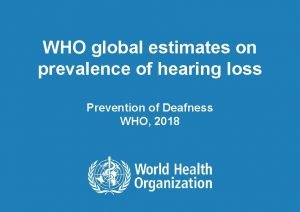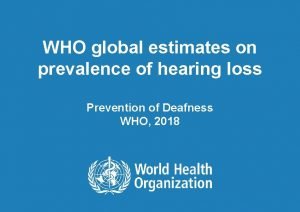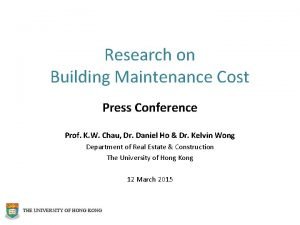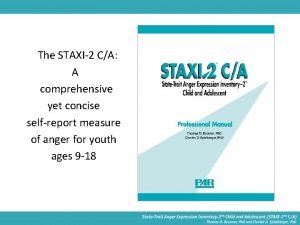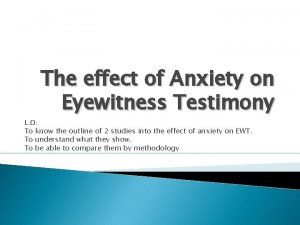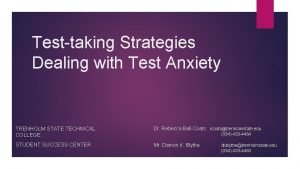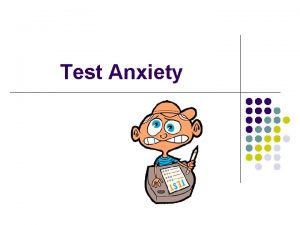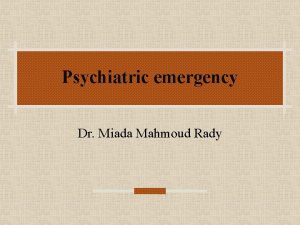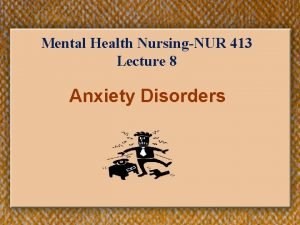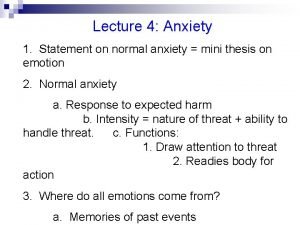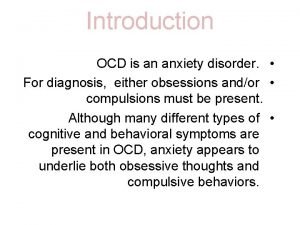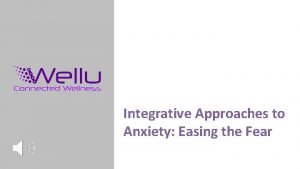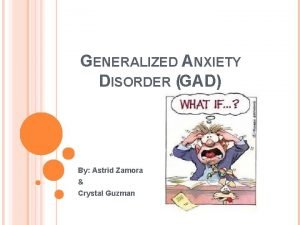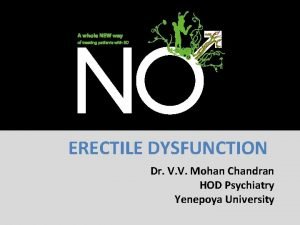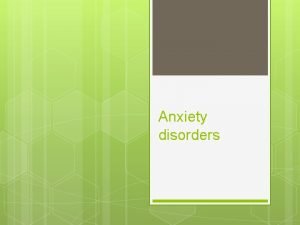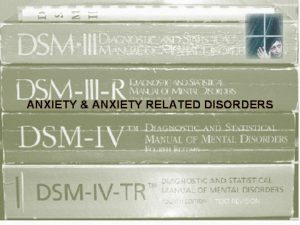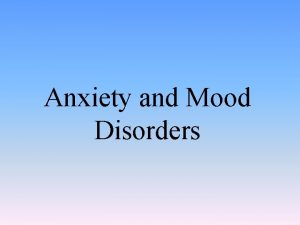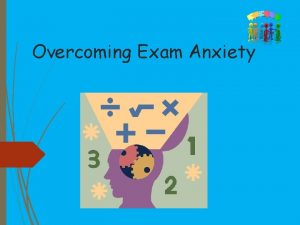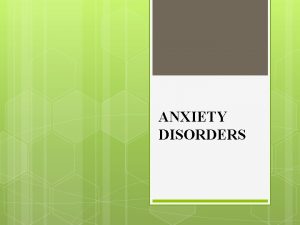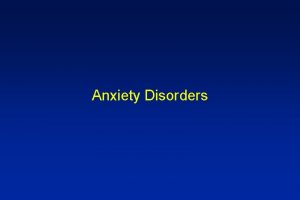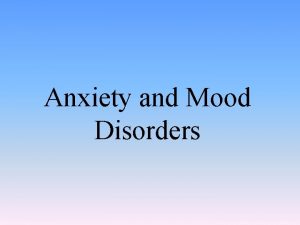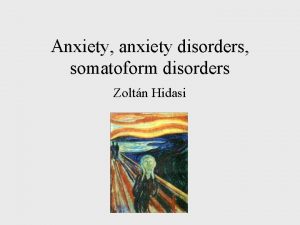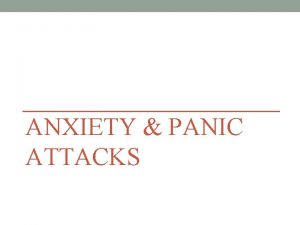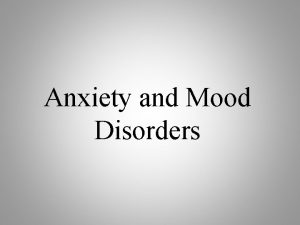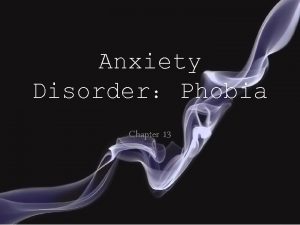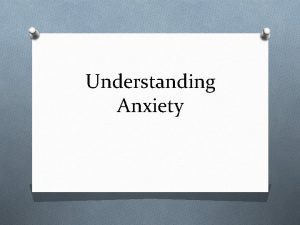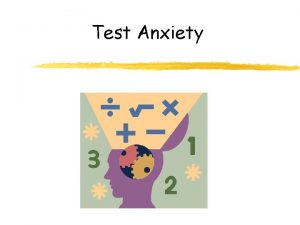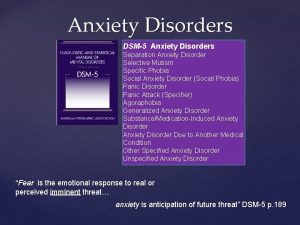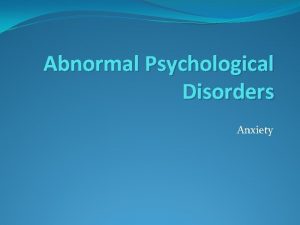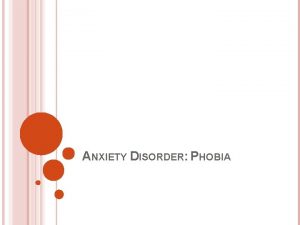Estimates of parents anxiety level using state trait






























- Slides: 30

Estimates of parents anxiety level using state trait anxiety inventory (STAI) in situations of acute unplanned childhood hospitalization in the emergency department (AUCHED): Preliminary results of the AUCHED research programme Hashim Embong National University of Malaysia (UKM) April 2016 HE 1

Overview • Children account for 20 -30% of total population of patients in Emergency Department. (Booz, Allen & Hamilton, 2007; NSW Health, 2002) • Children-friendly Emergency Department (ED) is no longer a new concept, and has been established and promoted over the years especially in the United States and Australia. 2 April 2016 HE

BUILT ENVIRONMENT - Dedicated Pediatric ED -waiting times EQUIPMENTS, SUPPLIES, MEDICATION CLINICAL INTERVENTION PLAN -procedures, pain management -staff skills Missing component: EXPERIENCE? 3 Bursch, Beezy & Shaw, 1993; Thompsom, Yarnold, Adams & Spacone, 1996 a; Thompson, Yarnold, Williams & Adams, 1996 April 2016 HE OPTIMUM CARE

CAN THIS “CHAOS” BE FRIENDLY TO CHILDREN WHO ARE ILL? 4 April 2016 HE

THE UNRESOLVED ISSUE 1996 Sick child or hospitalisation of a child potentially disrupts the normal flow of family life, and it brings a huge unpredictable impact to the affected family. Therefore, it is important to consider children and parents’ physical, as well as psychosocial needs. Parents are inevitably worry and anxious about their children when they are ill or fall sick, so it is important to Children admitted to the hospital bring with them families from many different backgrounds, ethnicities, cultures, religions, and socioeconomic strata. Admission of a child to the hospital may be one of the most stressful events for parents, because the outcome is often uncertain, the procedures gain an understanding of what parents worry and concern about, and parents' anxieties to be addressed effectively so that are often painful, and intense emotions of anxiety, sadness, and anger are in constant flux. relevant information and education can be offered ( Micheal D. Aldridge et al, December 2005 (Joe Kai, BMJ, 1996). 5 2005 April 2016 HE 2016?

A DIRECT RELATIONSHIP TO OUTCOME significant association between the accompanying person’s levels of anxiety and satisfaction at point of discharge. The lower the level of ( Anna Ekwall et al Sept 2009) 6 April 2016 HE Anxiety Satisfaction of care Lower anxiety reported by accompanying persons when leaving the emergency department, the more satisfied they are likely to be with their emergency department visit. Ultimately, well informed and confident accompanying persons are beneficial for ensuring quality patient support. Higher There was a

COMMON SOURCES OF ANXIETY Hidden Agenda The chronically anxious parent Iatrogenic anxiety 7 April 2016 HE 6 The stressed parent Vulnerable Child Inexperienced parent (Steven R. Poole et al. August 1980).

A. U. C. H. E. D. RESEARCH PROGRAMME General Objectives To investigate the context and management of anxiety in relation to the creation of a child- friendly emergency department To quantify anxiety level of the parents/caregivers accompanying a sick child to the emergency department at presentation and its changes following completion of treatment to disposition and factor may influence these variables. 8 April 2016 HE

AUCHED Research Programme A systematic review of factors influencing experience of acute unplanned childhood hospitalisation in emergency department 9 April 2016 Linguistic validation of Malay translated self evaluation STAI questionnaire of parents’ anxiety relating to hospital visit HE Comparison between pre and post treatment anxiety levels of accompanying parents of sick children presenting to the ED Anticipatory factors influencing anxiety level among parents of sick children presenting to ED

What is STAI? 10 April 2016 HE

SPIELBERGER STATE TRAIT ANXIETY INVENTORY • Self administered questionnaire • Each item is a 4 point Likert scale • 40 items (20 items for acute anxiety, S-anxiety and 20 items for “baseline trait”, T-anxiety) • Possible Scores between 20 -80 • Higher scores indicating greater anxiety (checked against trait scores) • Validated in multiple populations • Translated in >60 languages 11 April 2016 HE

THE MORE DIVERGENT STATE-TRAIT, THE MORE ACUTE THE ANXIETY 80 STAT E TRAIT High score Under normal conditions, published mean for working adult males: 35. 7 (± 10. 4), adult females: 35. 2(± 10. 4) Barnes et al, 2002 20 April 2016 Low score HE 12

STATE 13 April 2016 HE TRAIT

Why parents, not children? 14 April 2016 HE

METHODS Cross-sectional study in ED, UKM Medical Center, Malaysia Apr 2015 to Apr 2016 15 April 2016 HE INCLUSION: - All parents older than 18 years of age with a living child or children age 12 years old and below, presenting to ED for a perceived need of acute medical care. - Unplanned or unintentional visit EXCLUSION: - Critically ill children - DID (dead in department). - BID (Brought in death ) - Suspected abuse/ OSCC (one -stop crisis center) cases. - Unable to communicate in spoken or written Malay/ English

Secondary triage 16 April 2016 HE

Secondary triage 17 April 2016 HE

Pediatric cubicle 18 April 2016 HE

Ethics • Approved by Institutional Review Board • (FF-2014 -253, FF-2015 -274, FF-2015 -283, FF-2015 -317) • Participation in this study is purely on voluntary basis. All patients, regardless they are included or excluded from the study, will received the standard ED management and care. • No monetary compensation for participation. • All data collected strictly confidential and only accessible by the research team members. 19 April 2016 HE

Preliminary Results (Pooled data) • 180 parents recruited over 8 months data collection (June 2015 – Feb 2016) 20 April 2016 HE

Patients by triage category RESUSCITATION SEMI CRITICAL 4 Red cases NON CRITICAL • Pneumonia • Acute bronchiolitis • Febrile fits, • Anaphylaxis MEDIAN AGE 3, IQR 5 21 April 2016 HE

Top 8 common presentations 22 April 2016 HE

Comparison between actual and expected duration of stay No beds! Actual Median 2. 25 IQR 1. 41 23 April 2016 HE Expected Median 2. 00 IQR 2. 00

Respondents’ Demographic Profile Mean age for parents/guardians: 33 years old (eldest 60 years old) Mostly Malays. “University-educated, working, & mothers” 24 April 2016 HE

Respondents demonstrate acute anxiety on STAI TRAIT STAT E 80 50 20 April 2016 Mean S-anxiety score 53. 37, SD ± 11. 79 HE Mean T-anxiety score 39. 31, SD ± 7. 50 25

Comparison of S-Anxiety to other studies What is the cut off for “normal”? Parental anxiety following a paediatric concussion Parents of children seeking for ED care 26 April 2016 HE Parents of children seeking treatment at paediatric walkin clinic Parents of children with fever

Analysis of respondents with highest S-Anxiety Why are they worried? • • • 27 April 2016 First time presentation Very pronounced sign- bleeding Waiting too long Disease did not response to initial treatment Prior experience- febrile fits HE

Conclusion • Anxiety of parents with children seen at the Emergency Department can be feasibly measured. • Parental anxiety here is elevated by 30% or more, from baseline (trait). 28 April 2016 HE

What is next? • Need to set target of significantly meaningful anxiety reduction. • Indicator for improvement of the ED environment • May need to create a modified version of STAI for use in the ED • Next is the children. 29 April 2016 HE

Further reading. • • • 30 April 2016 Zemek R, Clarkin C et al (2013), Parental anxiety at initial acute presentation is not associated with prolonged symptoms following pediatric concussion, Acad Emerg med 20(10): 1041 -9 Jennifer S Needle, Maryann O’Riordan, Paul G Smith ( 06/2009 ). Parental anxiety and medical comprehension within 24 hours of a child’s admission to the paediatric intensive care unit ABooz, Allen & Hamilton (2007), Key Drivers of Demand in the Emergency Department, NSW Department of Health, Sydney, Australia Nathan D. Magaret BS, Thomas A. Clark MD, Craig R. Warden MD, MPH, A. Roy Magnusson MD, MHA and Jerris R. HEDGES MD, MS ( 2008). Patient Satisfaction in the Emergency Department—A Survey of Pediatric Patients and Their Parents Thompson, D. A. , Yarnold, P. R. , Adams, S. L. , Spacone, A. B. , (1996 a). How Accurate Are Waiting Time Perceptions of Patients in the Emergency Department? Annals of Energency Medicine 28(6) 652 -656 Thompson, D. A. , Yarnold, P. R. , Williams, D. R. , Adams, S. L. (1996 b). Effects of actual waiting time, perceived waiting time, information delivery and expressive quality on patient satisfaction in the emergency department. Annals of Emergency Medicine, 28 (6), 657 -665 HE
 Stai items
Stai items Frida kahlo parents
Frida kahlo parents Parents parents
Parents parents Frida kahlo famille arbre généalogique
Frida kahlo famille arbre généalogique Who global estimates on prevalence of hearing loss 2020
Who global estimates on prevalence of hearing loss 2020 Who global estimates on prevalence of hearing loss 2020
Who global estimates on prevalence of hearing loss 2020 1/4percentage
1/4percentage Least square property
Least square property Creative industries economic estimates
Creative industries economic estimates Building maintenance cost estimates
Building maintenance cost estimates Marquis company estimates that annual manufacturing
Marquis company estimates that annual manufacturing Tom murphy physics
Tom murphy physics Fermi problems
Fermi problems The account analysis method estimates cost functions
The account analysis method estimates cost functions Marquis company estimates that annual manufacturing
Marquis company estimates that annual manufacturing Comprehensive yet concise
Comprehensive yet concise How anxiety affects eyewitness testimony
How anxiety affects eyewitness testimony Relaxation techniques test anxiety
Relaxation techniques test anxiety Anxiety symptoms
Anxiety symptoms I'm a perfect example of someone who has math anxiety
I'm a perfect example of someone who has math anxiety Neurotic behavior
Neurotic behavior Neurotic definition
Neurotic definition Disturbed thought process nursing diagnosis
Disturbed thought process nursing diagnosis Examples of generalized anxiety disorder
Examples of generalized anxiety disorder Chapter 8 managing stress and anxiety
Chapter 8 managing stress and anxiety Neurotic anxiety example
Neurotic anxiety example Ego dystonic
Ego dystonic University of wisconsin integrative medicine anxiety
University of wisconsin integrative medicine anxiety Examples of generalized anxiety disorder
Examples of generalized anxiety disorder Frustration anxiety and tension
Frustration anxiety and tension Sharat chandran
Sharat chandran




